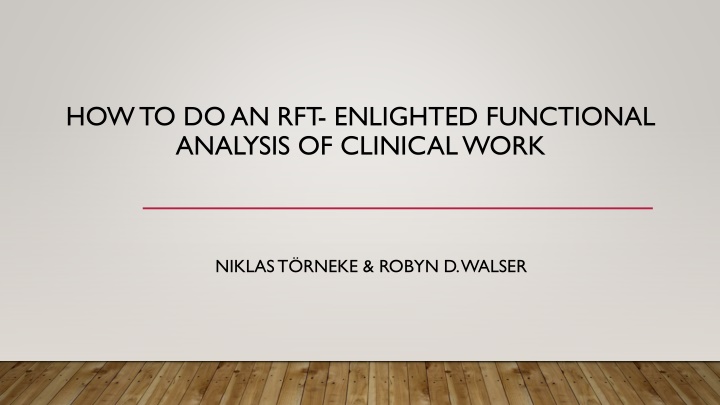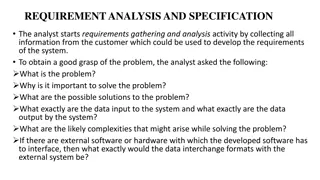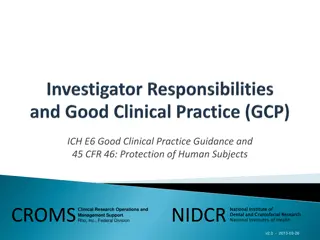HOWTO DO AN RFT- ENLIGHTED FUNCTIONAL ANALYSIS OF CLINICAL WORK
Analyze symbolic behavior in clinical work, understanding the impact of self-instructions and observational distance. Train clients in functional analysis strategies for behavior change.
Download Presentation

Please find below an Image/Link to download the presentation.
The content on the website is provided AS IS for your information and personal use only. It may not be sold, licensed, or shared on other websites without obtaining consent from the author.If you encounter any issues during the download, it is possible that the publisher has removed the file from their server.
You are allowed to download the files provided on this website for personal or commercial use, subject to the condition that they are used lawfully. All files are the property of their respective owners.
The content on the website is provided AS IS for your information and personal use only. It may not be sold, licensed, or shared on other websites without obtaining consent from the author.
E N D
Presentation Transcript
HOWTO DO AN RFT- ENLIGHTED FUNCTIONAL ANALYSIS OF CLINICAL WORK NIKLAS T RNEKE & ROBYN D. WALSER
THE BASIC PHENOMENA Men act upon the world and change it, and are changed in turn by the consequences of their action (Skinner,1957 in Verbal Behavior, p. 1).
SYMBOLIC BEHAVIOR CHANGESTHE THREETERM CONTINGENCY (A-B-C) Responses of the behaving person can aquire complex antecedent functions for further behavior and become self-instructions (tell you what to do and for what) Responses of the behaving person, in the form of abstract, overarching verbal constructions, can aquire reinforcing or punishing functions. The above is for good and for bad. RFT explains how and why.
THE LIGHT SIDE OFTHE FORCE We are able to sidestep immidiate gratification We can go for long term consequences
THE DARK SIDE OFTHE FORCE Our ability to follow self- instructions can lead to viscious circles Experiential avoidance
ESTABLISHING OBSERVATIONAL DISTANCETO YOUR OWN RESPONDINGAS A KEY STRATEGY Human language developed for cooperation and influence Silent languaging has a similar function: problem-solving, planning. To the extent to which a person interacts with her/his own self-instructing responses in coordination, these responses will have strong influence on subsequent behavior and the person risks missing other aspects of the current context (including other responses of her/his own) and be trapped in viscious circles (fusion & experiential avoidance) Thus responding to your own responding in hierarchy with deictic I (with an observational distance) is an antidote to the above and the very essence of psychologial flexibility
DOINGA FUNCTIONALANALYSIS: THE BEGINNINGAND END OFALL CHANGE STRATEGIES Find and name, in co-operation with the client, the current problematic strategy the client uses and clarify relevant antecedents and consequences (functional analysis, A B C analysis, creative hopelessness) Train the client in establishing observational distance (framing in hierarchy with deictic I, defusion/self as context) to self-instructing responses functioning as important antecedent factors to the problematic strategy, in order to alter the functions of such responses as they emerge. Train the client in using observational distance (framing in hierarchy with deictic I) of both antecedents and consequences that support an alternative strategy (taking direction, valued action)
SKINNER, IN CONCLUSION: A person who has been made aware of himself by the questions he has been asked is in a better position to predict and control his own behavior (Skinner, 1974 in About Behaviorism p. 35).
REFERENCES RFT for Clinical Practice: Three Core Strategies in Understanding and Treating Human Suffering. T rneke, Luciano, Barnes-Holmes & Bond 2016. In Zettle, Hayes, Barnes-Holmes & Biglan (ed.), Wiley handbook of contextual behavioral science p. 254 272 Metaphor in Practice. A Professional Guide to Using the Science of Language in Psychotherapy. T rneke, 2017 The Heart of ACT: Developing a flexible, process-based and client-centered practice using Acceptance and CommitmentTherapy. Walser, 2019























